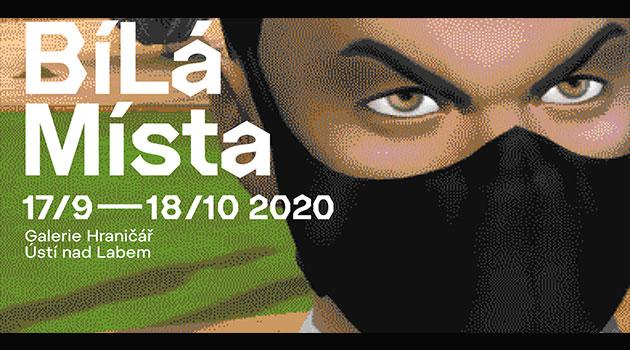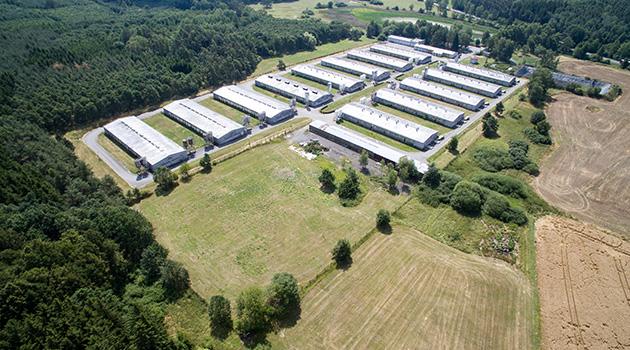Czech town to see exhibition by pro-Romani and Romani artists referencing the Black Lives Matter movement

Tomorrow, 16 September 2020, the art exhibition “BíLá Místa” (“White Spaces”) will open at Galerie Hraničář in Ústí nad Labem, Czech Republic – the letters “BLM” standing for “Black Lives Matter” have been capitalized in the name of the exhibition. The opening will take place at 18:00.
The exhibiting artists are Natálie Kubíková, Lea Kupková, Tamara Moyzes, Martin Zet, Romane Kale Panthera, Lukáš Houdek, Oto Hudec, QRSTOCK, ARA ART, z.s. and the Divadlo Husa na provázku theater company. On 8 October at 20:30 the documentary film “LETY” by ROMEA TV will screen at the gallery.
The exhibition was curated by Věra Duždová Horváthová and Vendula Fremlová. The visual identity for it was designed by Magdaléna Gurská and Natálie Kubíková.
A guided tour of the exhibition will be held tomorrow at 16:00. The opening will then take place at 18:00 with a performance by Martin Zet, David Tišer and Pavlína Matiová (produced by ARA ART, z.s. & the Divadlo Husa na provázku theater company) of an excerpt from the play “Gadžové jdou do nebe” (“Gadje Go to Heaven”).
“The dominant culture, cultural habits and cultural conventions inscribe themselves into the form and practices not just of cultural and educational institutions and organizations, but also at a general level into cultural policies and at the concrete level, into artworks as well. Currently, in association with the global Black Lives Matter movement, we are able to follow an iconoclastic reaction to the statues of and memorials to political and state-related figures in the public space who are or who were associated with racism, segregation and support for systems of slavery,” write curators Věra Duždová and Vendula Fremlová.
The removal of statues and memorials associated with racism, according to the curators, raises various questions. For example, to what extent is the placement of such monuments in the public space today justified?
How numerous are the memorials and monuments reminding the public of minorities and their notable representatives? Is the removal of a public artwork an adequate response to such issues, or not?
Within the framework of this issue, is the discussion happening among both experts and the general public taking place sufficiently and satisfactorily, or is it happening minimally – or not at all – or is it absolutely distorted? How is this issue perceived in the Czech and Slovak environment?
According to the curators, the name of the exhibition references the absence and invisibility of minorities in majority culture. “The exhibition focuses on works by Romani and pro-Romani artists, female and male, who question the issue of dominant cultural and linguistic (textual and visual) practices and thereby reveal them,” the curators point out.
“On a map, white space signifies emptiness. The margins of our cultural and institutional history and present are also white spaces,” the curators say.
The exhibition and its accompanying events are happening at the Galerie Hraničář. In 2018 the gallery became the location of a much-criticized discussion ahead of the elections when the Ústecký Regional Parliament of Children and Youth invited the ultra-right extremist Tomáš Vandas to speak there.
The invitation to Vandas, who is associated with the neo-Nazi Workers Party, which was dissolved by the Czech courts in 2010, and who is currently chair of the Workers Social Justice Party, was criticized at the time by the Terezín Initiative Institute or the Committee for the Redress of the Roma Holocaust. The curators of “BíLá Místa” are aware of the problematic situation that arose at the gallery in September 2018.
“We perceive our installation of an exhibition focused on Romani and pro-Romani artists at that same institution to be a way for us to take back this public cultural space and to restore the voices, issues and subjects that continued to be sidelined and which it is necessary, especially in northern Bohemia, to raise and to submit to the broadest possible audience,” the curators told news server Romea.cz. The exhibition project has been created in association with the ARA ART, Divadlo Husa na provázku, and ROMEA organizations.
EXHIBITION PROGRAM
29. 9 at 16:00 | Guided tour of the exhibition with artist Lukáš Houdek
4. 10. at 15.00 | Arts workshop for children with artist Lea Kupková
8. 10 at 20:30 | Screening of the film “Lety”, followed by a debate with filmmakers Viola Tokárová and Mgr. Renata Berkyová of the Institute of Contemporary History of the Academy of Sciences of the Czech Republic.
9. 10. at 18.00 | Guided tour of the exhibition followed by a discussion with Dominika Moravčíkováu (Kapitál noviny magazine) with her guests + LÁSZLÓ FARKAS “GYPSYROBOT” (DJ and Roma LGBTQI activist) + Alex Dzurko (rapper).
